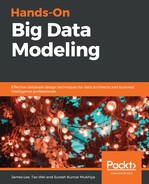A graph is a just a collection of vertices and edges. The most convincing example of a graph-data model is a social network. Each piece of information in this world is connected. To store and process information correctly, a database must embrace and store the entity and its connectivity with another entity. This is where the graph-data model kicks in. Storing and accessing nodes and relationships in a graph database is an easy, efficient, and constant-time operation that permits a user to quickly traverse and get correct information.
 ( V X V). The elements of V are the vertices or nodes of the graph, G, and the elements of E are its edges or relationships.
( V X V). The elements of V are the vertices or nodes of the graph, G, and the elements of E are its edges or relationships. Let's see a graph model of movies and actors.

From the movie data model given in the preceding diagram, it's clear that we have the following vertex table:
| ID | Property (V) |
| 1 | (Person, Jackie Chan) |
| 2 | (Person, Dwayne Johnson) |
| 3 | (Movie, Kung Fu Panda) |
| 4 | (Movie, Moana) |
| 5 | (Movie, Skyscraper) |
| 6 | (Person, John Stevenson) |
| 7 | (Person, Ron Clements) |
| 8 | (Person, Rawson Marshall Thurber) |
The corresponding edge table of the graph would be:
| Source | Destination | Property(E) |
| 1 | 3 | ACTED_IN |
| 2 | 4 | ACTED_IN |
| 2 | 5 | ACTED_IN |
| 6 | 3 | DIRECTED |
| 7 | 4 | DIRECTED |
| 8 | 5 | DIRECTED |
From the preceding diagram, the following observations can be made:
- The data model is a graph model that shows nodes (person, movies) and relationships (ACTED_IN and DIRECTED)
- Nodes can be labeled with one or more labels, which is good for identification
- Nodes can contain properties where properties are stored as a key-value pair
- Relationships can be named and directed
- Relationships have a start and end node
